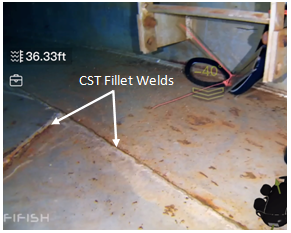The Essential Function of Storage Tank Welding Evaluation in Ensuring Structural Integrity and Safety And Security Compliance in Industrial Applications
In the world of industrial applications, tank welding inspection becomes a crucial element in safeguarding architectural honesty and making sure compliance with safety policies. Using a mix of methods such as visual evaluations and progressed testing techniques, these inspections serve to recognize and mitigate potential imperfections prior to they escalate right into substantial risks. The ramifications of these techniques extend past simple regulative adherence; they basically impact functional efficiency and possession durability. The intricacies surrounding the assessment process prompt a closer examination of its methods and end results, disclosing layers of importance that quality more expedition.
Importance of Storage Tank Welding Inspection

Making certain conformity with market criteria and regulations is another considerable facet of tank welding inspection. Regulative bodies mandate strict standards for the building and upkeep of storage containers, and thorough examinations aid organizations abide by these requirements. Non-compliance can result in serious charges, including penalties and closures, additionally stressing the requirement for strenuous examination procedures.
Furthermore, storage tank welding evaluation plays an essential duty in maintaining operational performance. Normal assessments can determine potential issues prior to they rise, facilitating timely repair work and lessening downtime. This proactive strategy not only improves safety but likewise adds to set you back savings over time. In summary, the importance of tank welding assessment exists in its ability to safeguard public wellness, safeguard the environment, and make sure compliance with regulative structures.
Secret Evaluation Techniques
Effective storage tank welding inspection counts on a range of crucial techniques that make certain detailed analysis of weld top quality and architectural stability. Amongst the most common techniques are visual inspection, ultrasonic screening, radiographic testing, and magnetic particle screening - Tank Welding Inspection. Each technique supplies unique benefits in analyzing various aspects of the weld
Aesthetic evaluation acts as the initial line of protection, enabling assessors to determine surface area flaws, abnormalities, or variances in the weld grain. Ultrasonic testing uses high-frequency acoustic waves to find interior flaws, such as splits or gaps, giving a thorough assessment of weld integrity. This method is especially effective in spotting issues that may not be noticeable externally.
Radiographic testing utilizes X-rays or gamma rays to create photos of the welds, revealing internal discontinuities and giving an irreversible record for future recommendation. This strategy is very reliable for vital applications where the danger of failing need to be reduced.
Lastly, magnetic bit screening is utilized to identify surface area and near-surface flaws in ferromagnetic materials. By applying magnetic areas and great iron particles, inspectors can identify gaps that may compromise the structural stability of the container. Together, these strategies develop a robust structure for ensuring high-quality welds in industrial applications.
Compliance With Safety Requirements

Regular assessments play a pivotal duty in guaranteeing conformity by recognizing prospective failures or variances from prescribed standards. Inspectors are trained to assess weld top quality, verify material specifications, and assess the general structural integrity of storage tanks. Their knowledge is important in guaranteeing that welding processes satisfy the required safety and security criteria.
In addition, compliance with safety requirements not just secures employees yet likewise safeguards the setting from possible risks such as leaks or devastating failings. Organizations that focus on security compliance are better positioned to reduce dangers, enhance functional performance, and foster a culture of safety and security within their labor force. In summary, keeping extensive conformity with security requirements is important for the effective operation of tank welding activities navigate here in industrial setups.
Advantages of Regular Assessments
Routine inspections are indispensable to maintaining the structural integrity and safety and security of bonded containers. These evaluations provide an organized method to determining possible flaws or weaknesses in the welds, ensuring that any issues are addressed prior to they escalate right into significant failures. By carrying out regular analyses, companies can discover rust, fatigue, and other forms of deterioration that may compromise tank performance.
In addition, regular evaluations add to compliance with market guidelines and standards. Sticking to these guidelines not only reduces legal risks but likewise enhances the organization's reputation for safety and security and integrity. Routine inspections promote a proactive safety and security culture, motivating workers to acknowledge and prioritize the importance of devices integrity.

Study and Real-World Applications
Instance researches and real-world applications illustrate the concrete effect of effective tank welding examination practices. Following the execution of strenuous welding inspection methods, consisting of aesthetic and ultrasonic testing, the facility identified vital defects in weld seams that might have led to devastating failures.
Similarly, a water treatment plant applied an extensive inspection program for its container welding procedures - Tank Welding Inspection. By incorporating non-destructive testing methods, the plant was able to find early indicators of rust and tiredness in weld joints. This timely intervention prolonged the lifespan of the tanks and made certain compliance with safety and security laws, hence protecting public wellness
These study underscore the significance of regular and systematic container welding assessments. By prioritizing these techniques, sectors can reduce threats, boost architectural stability, and make sure compliance with safety and security requirements, eventually leading to boosted functional efficiency and minimized liabilities.

Final Thought
In final thought, container welding inspection is an indispensable part of keeping structural stability and safety in commercial applications. Using different inspection methods makes certain very early discovery of possible defects, therefore avoiding disastrous failures. Adherence to security standards further boosts operational dependability and navigate here conformity with regulative needs. Ultimately, normal assessments not just secure public health and wellness and the setting but additionally add to the long life and efficiency of crucial possessions, highlighting the crucial function of this practice in commercial operations.